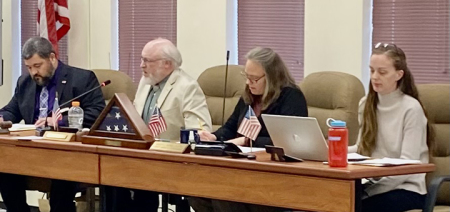Project Chenango: Creating And Keeping Chenango’s Jobs
Published:
September 17th, 2015
By Melissa Stagnaro
Special to The Evening Sun
stagnaro.melissa@gmail.com
CHENANGO – Steve Craig remembers the morning he learned that Norwich Aero was slated to close, taking 150 jobs with it.
“We were totally blindsided,” said Craig, CEO of Commerce Chenango.
The shocking news came by email, in the form of a press release issued by the aerospace manufacturer’s parent company, Esterline. Craig immediately started scrambling, reaching out to his contacts in Albany. He hoped that, working with the governor’s office and Empire State Development, they would be able to put a proposal together capable of pursuading the company to reconsider.
Those efforts were in vain.
“The decision had already been made,” he explained. “The wheels were already in motion.”
That decision had nothing to do with productivity, he said, and everything due to the company’s desire to consolidate its diverse international holdings in one place: an aerospace cluster in Tijuana, Mexico.
The Norwich plant is still in operation as Esterline orchestrates the move, but Craig and others have already begun to help market the 58,000 square foot facility. But they aren’t marketing the property on the merits of the structure alone.
“There are a lot of empty buildings in upstate New York,” Craig explained. “Our unique selling proposition is the workforce.”
Consultant Steve Palmatier, engaged by Chenango County and Commerce Chenango as a workforce and industrial development liaison, has played a key role in the effort. He can’t speak highly enough of Norwich Aero’s workforce.
“They are highly skilled at low volume, high mix manufacturing. Every day they are building something different,” he said. “That is unique.”
Their skill sets are diverse, as well.
“Look at what they can do,” he said, enumerating a list of specialties from laser welding, coil winding, encapsulation and hermetic seals, to engineering and specialized machining.
They also have an aerospace-qualified quality control department in place and are adept at meeting different international requirements.
“They are people who are used to working in a highly regulated industry,” he explained.
According to Palmatier, these skills, while honed in the aerospace industry, are transferable to other industries, including medical devices and specialty electronics. Thus making the Norwich Aero property a ‘turn-key’ solution to either an existing manufacturer looking to expand or a new venture.
“It would be very difficult to bring all of those skills together if you were trying to do a start up,” he said.
Craig agrees.
“That’s a workforce that takes a long time to develop, and we already have one here,” he said.
Why is he so sure this could be the key to finding a buyer for the property?
“The most frequently cited limiting factor in industrial expansion decisions is the lack of a qualified workforce,” he explained.
It was this thinking that prompted the decision to exhibit at a trade show hosted by the Society for Industrial Engineers early this year. Chenango County and Esterline anteed up to market Norwich Aero at the event. The show drew 10-12,000 people, Palmatier said, 1,500 of which took the time to hear the pitch.
They’ve had 35 to 40 inquiries as a result, he said, all of which they’ve followed up with. None have found it the right fit for their needs so far, but he and Craig continue to press on with their efforts.
“The reputation of New York State is hard to stave off,” said Craig, explaining that they’ve revised their strategy and are now concentrating on companies that already do business in New York and neighboring states, where the business environment is similar.
JOBS
It’s not the thought of the building sitting vacant that weighs most heavily on Craig’s mind. It’s the jobs.
While most people think of economic development as something that benefits businesses, the chamber executive says it boils down to one thing.
“Whenever you hear that term [economic development] in connection with Commerce Chenango, think ‘increasing the number and size of paychecks that are cashed and spent locally,’” he said. “That’s the bottom line for us.”
They do that by encouraging investment – both by attracting new business and helping existing employers grow. But that investment doesn’t happen if the business in question doesn’t expect to see a return. The whole point of economic development incentives, Craig explained, is to help businesses realize enough of a return to make the investment worthwhile.
“Bringing a little more money to the table, whittling away at costs, or both, can nudge that return-on-investment number into the acceptable range,” he said.
Development Chenango, the economic development arm of the chamber, works closely with other local partners to help businesses secure funding and incentives from a number of sources. That can include low-interest loans, matching grants, tax abatements and more.
SUCCESS STORIES
The collaboration between agencies has lead to a number of success stories, according to Craig. Included in that list are companies such as Chobani, CWS Packaging, CZ-USA, Golden Artist Colors, Norwich Meadow Farms, Norwich Pharmaceuticals (now called Norwich, an Alvogen Company), Raymond Corporation, Tecnofil, Wagner-Nineveh, Baillie Lumber, Mid-York Press, Standard Printed Circuits and Chenango Pet Foods.
It’s not only larger businesses that can benefit. The Artist’s Palette, A Touch of Moore, Highland Hopyard in Smyrna and Lillie Farm Supply in Smithville are among the small businesses that have received funds through micro-enterprise grant programs.
Chenango is part of Empire State Development’s Southern Tier Regional Council, which Craig says has found a way to allocate funds more efficiently through its Consolidated Funds Application process. The Sherwood Hotel, Purdy’s Meats, the Kip Law Dairy, Sunrise Family Farms, Cascun Farms, Hayworth Holdings and Hercules Properties are entities that have all either benefited or will benefit from low interest loans made available through this program.
There is also what he calls the ‘rescue’ of the former Salvation Army/Fishman’s building on Broad Street in Norwich. This project is one of several revitalizations ongoing in the City of Norwich.
“Revitalization preserves the sense of place in an historic area, while creating economic assets for the future,” said Craig.
Todd Dreyer, planning and community development specialist for the city, explained why these projects are so vital to downtown Norwich.
“Norwich has a lot of aging buildings and infrastructure,” he said, which can be difficult for businesses both maintain and bring up to new code requirements. “To remain competitive and to keep our downtown vibrant, these businesses sometimes need the support of grant and low-interest loan programs to even the playing field.”
One of the areas targeted for redevelopment is the Stevens Heritage block at intersection of Lackawanna and North Broad Street in the city. The project, which is expected to take two years to complete, includes the renovation of seven buildings to create new commercial and residential space downtown.
CHALLENGES
Sometimes, it can feel like an uphill battle. Especially when jobs are lost instead of gained.
“It’s really demoralizing,” said Craig, once again recalling the day he learned of the impending Norwich Aero closure. “We work hard for each job. When they are going to take out 150 jobs, it’s devastating.”
There are also critics who call economic development programs a form of ‘corporate welfare.’
In Donna M. Jones’ tenure as head of Chenango County’s Planning Department, she’s attended a number of the public hearings required before tax abatement benefits are granted. She’s heard protests not only from residents, but also elected officials.
“Communities and local governments have a hard time understanding the benefits at times,” she said.
Payment In Lieu of Tax (PILOT) agreements are the most controversial. The agreements, granted by the Chenango County Industrial Development Agency (CCIDA), allow companies to make a predetermined payment each year rather than their full tax bill. According to Craig, the goal of these agreements is to “phase in the additional property tax bite that would otherwise hit all at once when a major investment is made.”
Craig stressed that the taxing authority doesn’t see a decrease in the taxes paid.
“Even in year one, with a payment equivalent to just 5% of the full tax burden, the county, town, and school district typically receive more money than they would have if the project had not been built,” he explained.
Craig has tried to address the issue through communication. He now tries to bring interested parties – particularly town governments – earlier in the process and starts public hearings with an information session.
Five Chenango County businesses currently have PILOT agreements in place with the CCIDA: Bytheway Publishing, Chobani (2), Norwich Pharma, Who’s We/Eaton Center, Tecnofil and NYSW Railroad.
Sales tax abatements are also often met with criticisms, as well. Economic developers state that these abatements encourage businesses to source materials locally as they only see the savings on purchases when they do.
Dreyer says he can understand where critics are coming from.
“I think there is a natural tendency among all of us to support initiatives that directly benefit us or our families,” he said. “I would encourage folks o appreciate how economic and community development programs help the community as a whole and provide far-reaching indirect benefits to us all.
And what if a company promises jobs, but doesn’t deliver?
According to Commerce Chenango Economic Development Specialist Liz Bunce, there are provisions in place to prevent that. Once the agreements are signed, she explained, companies must prove that they are making the investments and creating or retaining the jobs they promised.
“Monitoring is conducted throughout the project to ensure the requirements are being met,” she said.
If they don’t follow reporting procedures, they must forfeit the benefits. To make this easier to enforce, newer agreements include clawback clauses – which give teeth to an agency’s ability to retract funds if a company fails to meet their obligation.
Competition is also a factor that is always in the back of an economic developer’s mind.
“It’s become a common refrain to say government shouldn’t try to pick winners and losers,” said Dreyer. “But, in my opinion, if government isn’t engaged in trying to advance forward-thinking policies and programs, we’re going to lose out to our regional and global competitors.”
ACCESS TO FUNDING
Perhaps nothing is more frustrating for economic developers than when there is money available, but those who could benefit can’t qualify.
According to Jones, the property tax cap has created just such a situation.
“There are great grant opportunities, but there has to be a local share,” Jones explained. “Due to the cap, local governments don’t have the money to come up with the matching funds.”
The Chenango County Economic Development Revolving Loan Fund, which Jones administers, is another example. The loan fund is self-perpetuating - as one company pays back their loan, those funds are used for the next loan. Only right now, there are no new loan applications.
“It was originally started for manufacturers and industrial development, but there are other businesses that could use those funds,” she said, unfortunately they don’t qualify under the current guidelines.
The problem lies in the fact that the original grant funding that created the revolving fund originated from a Community Development Block Grant, awarded through the U.S. Department of Housing and Urban Development (HUD).
“There are national objectives that have to be met,” she said.
Currently, a company must produce 1 full-time job for every $10,000 borrowed, for a maximum of $75,000, something Jones doesn’t feel is realistic in today’s economy.
Jones would rather see that money at work in the community, than sitting idle. She’s working on revising the guidelines so others, particularly smaller businesses and farms, will be able to qualify. To put her plan into action, however, she’ll need not only approval from the county, but also at the state and federal levels as well.
THE WHOLE PICTURE
Even with resources at their fingertips, there is a limit to what economic developers can control.
“Governments at various levels can step in to provide incentives, but market factors are the primary drivers in determining where a new store will open or where a new office or plant will locate,” Dreyer said.
Dreyer, Craig, Jones and Palmatier all agree that the key to attracting and retaining business and jobs goes beyond economic development incentives. It often comes down to whether the infrastructure is there to support the needs of both the business and their workforce. That includes transportation, broadband, sewer and water, energy, communication infrastructure, housing, healthcare and more. Chenango County faces challenges in many of those areas.
“The future of our community is going to depend on the efforts of all of us working together to face challenges and overcome obstacles,” Dreyer said.
“The future of our area can be as bright as we choose to make it.”
Comments







